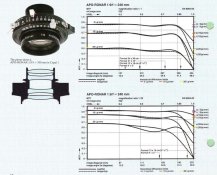As wrong as you are you are entitled to your opinion. The 75 was designed for duplicating 35mm to 35mm.
Bob, sorry if I was not clear, I was speaking about the 120mm which is specified for 4x5", I only posted the graph of the 75mm (as I explained) to show the D nature as I only had that graph.
But no doubt that you have first class information from having sold entire truckloads of those glasses, I'm aware.
Here is my complete collection of Norma Rodenstock Apo Ronars, I don't have a 1070mm F11 but I'm watching one
This is an impressive armored division. We can recall Wolf's work with the long ronars !
Let me point that there is an interesting article in the
"Internationale Phototechnik" 8/1993.
In that issue it is described how to optimize the inter-cell spacing (Shimming the front cell) to get optimal results for distant shootings with the ronar and the claron:
Reported by Peter K:
"Focus the center of your ground-glass on fine structures in the distance like leafless trees or high grasses with a strong loupe at wide open aperture.
Shift the rear frame of your camera to the left and the front frame to the right up to the point you can see the structures get blurry.
Unscrew the front group of the lens circa 2 mm (1 line or 0.08 inch) from the shutter or barrel and look for the fine structures, twigs or leafs. Adjust the distance between the front group and the shutter up to the point the structures are as sharp as possible without any coma and blur. Refocus if necessary during the adjustment.
Place a steel or brass shim of the determined thickness between shutter and front group. If the thickness of the shim is the correct one there is no difference in image quality between the center and the edge of distant subjects. For close-up work remove the shim or place a much thinner one."
Those adjustments can be necessary for the corners, the center is always good even when shooting far with the inter-cell spacing optimized for close work.
 Norma Copy Setup 4x5 1to1 180 Componon by Nokton48, on Flickr
Norma Copy Setup 4x5 1to1 180 Componon by Nokton48, on Flickr




 Norma #4 Copy Stand Finally Together
Norma #4 Copy Stand Finally Together


 Norma Rodenstock Apo-Ronar collection
Norma Rodenstock Apo-Ronar collection Norma #4 Copy Stand Finally Together 2
Norma #4 Copy Stand Finally Together 2 Shades 45 degree High Contrast Pol Test 1
Shades 45 degree High Contrast Pol Test 1 Maki Std Copy Test Shades 180mm F3.2 GX680
Maki Std Copy Test Shades 180mm F3.2 GX680 Broncolor Balloon and FOBA Sweep Table
Broncolor Balloon and FOBA Sweep Table Here I have attached it by FOBA Combitube to the DIMIL Sweep Table next to the Overhead Shooting Table.
Here I have attached it by FOBA Combitube to the DIMIL Sweep Table next to the Overhead Shooting Table. Sinar Norma 8x10 Overhead Reflex Rig
Sinar Norma 8x10 Overhead Reflex Rig 8x10 18x24 Sinar Norma Overhead Shooting Table 165 Norma SA
8x10 18x24 Sinar Norma Overhead Shooting Table 165 Norma SA